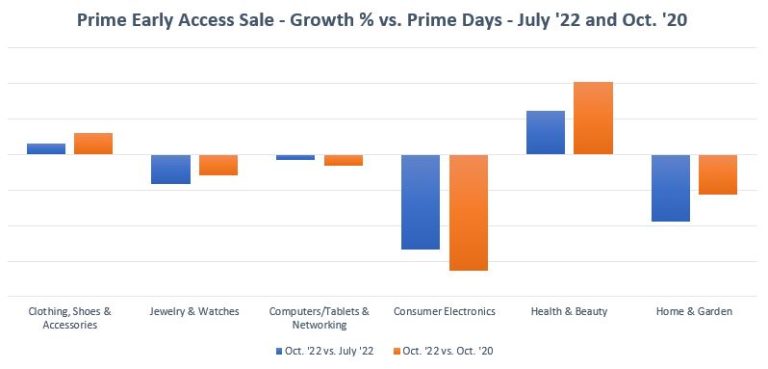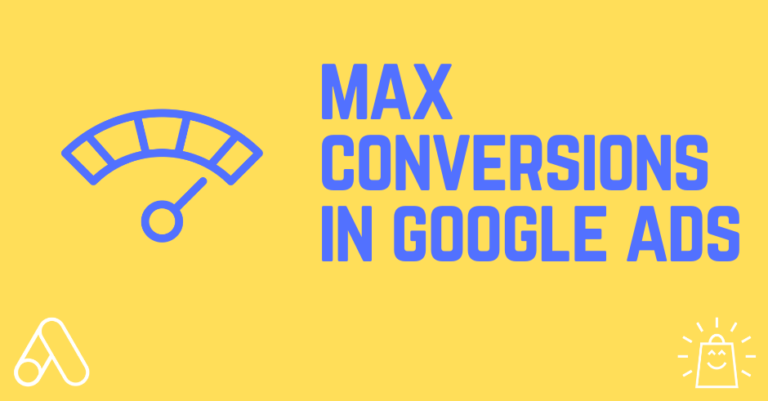Our top ecommerce platforms are based on objective performance data, feature set and, value. Compare the best ecommerce website builders to find one that fits your needs.
Here Are The Best Ecommerce Platforms
Top Ecommerce Platforms Compared
From cool marketing features to drool-worthy SEO, multichannel functionality, and more. Compare these best ecommerce platforms.
When you look at ecommerce software, it can be really hard to tell how seemingly minor differences in features and performance can have a major impact on your bottom line, but they can.
All vendors say they’re faster, more reliable, better geared for search engine optimization, PCI ready for credit cards, etc. than the competition. But what’s the reality?
The last thing I want is for you to customize your ecommerce site and load up your products only to have it running super slow. Or find out you need to spend an additional $399 a month to sync your inventory to Amazon and dropship products.
We decided to compare the features, performance, ease of use, design & themes, and integrations of the top ecommerce platforms using real site data. You’ll learn which platform meets your needs, performs the best, and gives you value to dominate your niche.
Additional Comparisons
Our Review And Testing Methodology
If you want real data, you have to run a lot of tests and have a systematic method of reviewing platforms for online stores. I only included the most popular platforms. I didnt include smaller, niche companies like Big Cartel.
Here is a brief explanation of how we got our results:
Objectively Choosing Sites From Each Platform
- We used BuiltWith to find the 10 most popular ecommerce platforms
- We created a filter to find active ecommerce sites running on each platform that spent at least $500 per month. This is a critical key difference between the original study. In the original study, we didn’t do this, and it created an unfair comparison. You can set up WooCommerce for super cheap compared to Shopify. If you are paying monthly for Shopify, you are more likely to be trying to market the site. So the previous study included under marketed (dead sites).
- We pulled a giant spreadsheet for all the websites on each platform (ex. our Magento list had 5K+ sites)
- Used RAND function in Google Sheets to assign a random number to each row
- Collected data on the first 100 websites on each platform (100 sites x 10 platforms = 1000 sites)
Collecting Data On the 1,000 Sites We Studied:
Used a team of 4 researchers (myself included) to collect data for each website
- Load time from Pingdom
- Mobile PageSpeed, Mobile UX and Mobile Friendliness From Google using URL Profiler
- Ranking Data From Ahrefs
Converting Raw Scores Into Meaningful Ratings
In our research, we measured overall scores in an average of value, features, performance, ease of use, design & themes, and integrations.
- Performance scores are based on storefront page load time, Google speed, SEO features, and ranking.
- Features are based on must-have and nice to have marketing features. Features were rated higher if they were included free, and lower if they were paid add ons.
- Ease of use is based on beginner friendliness, support available, partners/community involvement, app/plugins and their ratings, certified partners/community base, and developer friendliness.
- Integration looks at the ability to sell across multiple channels (ex. Amazon), compatibility with various business models (dropshipping) and other marketing automation integration. This is all about scalability as your online business grows.
- Design and theme scores are based on availability & number of free themes, mobile design rating, Google mobile UX score, mobile friendliness, and cost of premium themes.
BigCommerce
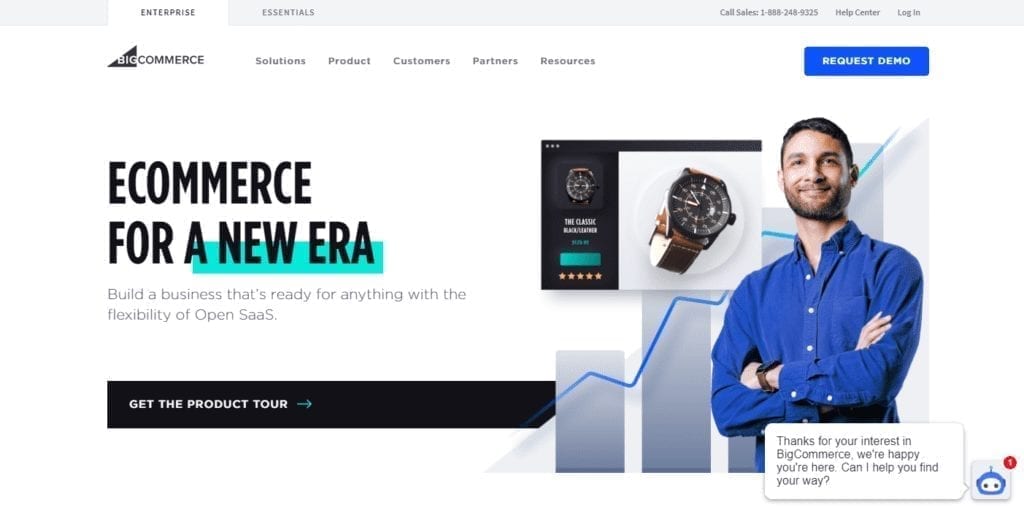
BigCommerce is the best overall ecommerce platform. Its robust product search engine makes it ideal for larger retail brands. It’s also a good choice for people who want to start an ecommerce store, or who have a brick and mortar store and want to expand their operations to include online orders. Its available tools make it possible for any niche or industry to be successful.
The interface allows you to customize your online shop without having to know how to code by using any of the customizable templates to design your store, sell and market your products. It’s aimed at those without so much web dev skills, but it also allows tech-savvy people to tweak the HTML and CSS.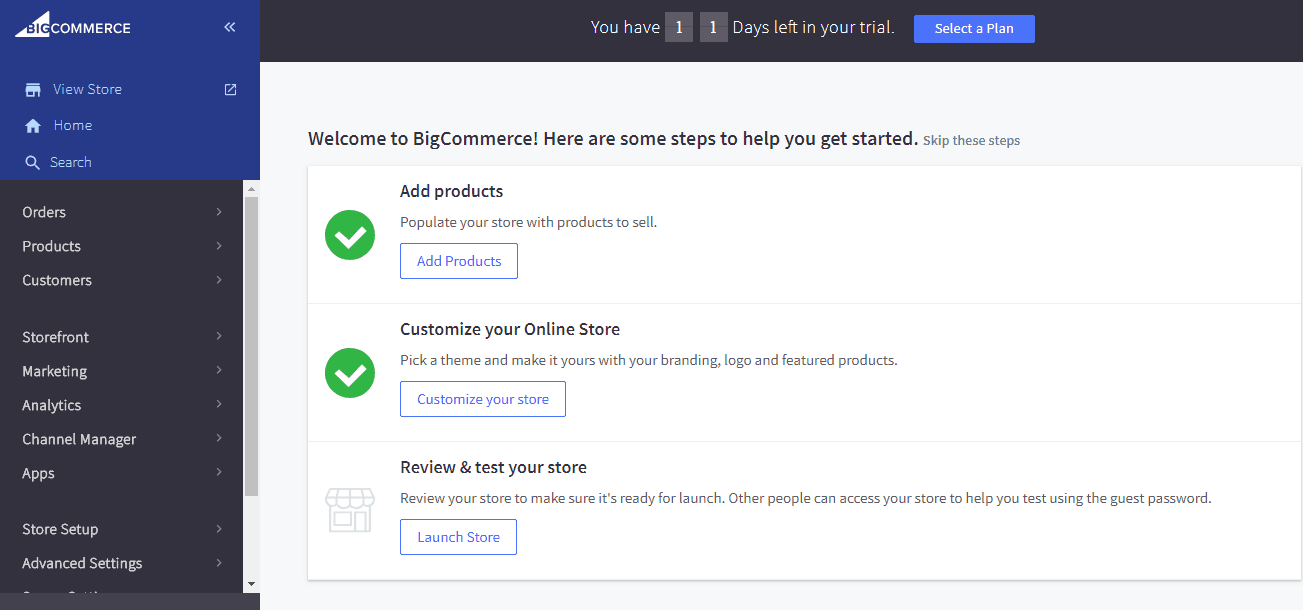
I love BigCommerce themes; you will see advanced and buyer-centric templates in the store, however only very few are free. Two to be exact with variations on both making a total of seven free themes.
On the fly side, there’s a broad community of designers and developers. The partner directory helps you find experts for an extra hand.
As for pricing, the lowest plan costs 29.95/month. Some goodies like checkout codes, gift cards, unlimited bandwidth, and professional reporting come along. However, you don’t get a custom SSL or abandoned cart saver, but it’s still really good for simple stores not getting sales worth more than 50k per year. As the plan goes higher, so does the sales limit.
Pros
- Flexible and scalable
- Excels with multi-channel selling
- Strong SEO Performance
- Fantastic Theme Designs
- Comprehensive abandoned cart feature
Cons
- Inconsistent speeds in consecutive studies
- Gets expensive for high volume stores
- Cart abandonment isn’t on entry plan
- No 1-click Selling/Upsells
Shopify

Shopify is the best platform at selling. If you plan to drop ship, rely on Facebook Ads or Instagram marketing – this is the best choice. I wouldn’t use Shopify if I was going to rely on SEO. I also wouldn’t use Shopify if I were creating a large store with many products. I’d use BigCommerce instead.
Shopify is slightly better in several areas over BigCommerce such as post-purchase 1-click upsells – but far behind in terms of performance. I’ve used Shopify on my site before and have worked with many Shopify sites in the past, but I like WordPress better because I have an affiliate revenue model in addition to products.
It’s easy to set up the online store with Shopify’s drag and drop interface. Most beginners to website development can get the hang of it in a few minutes.
Their apps are far too many to list.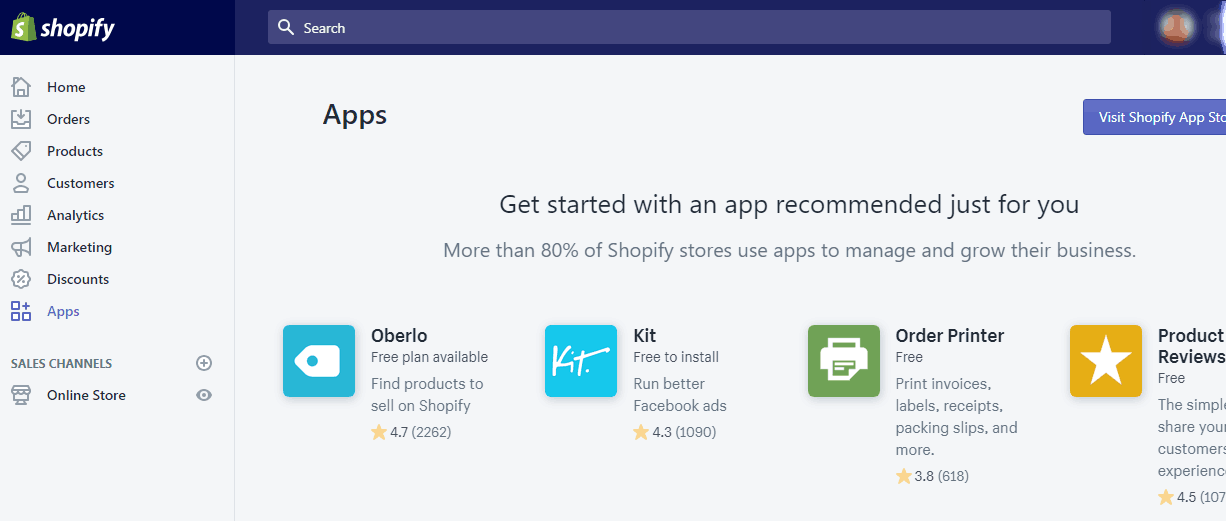
They also have the Shopify POS for simple brick and mortar stores looking to take payments via the mobile app. Complex stores can use it as well.
Like everything else, they have downsides. The not-too-bad one is that they have just 10 free themes right now. The paid themes hover around $100 to $180.
The big disadvantage they have is SEO. Weak ranking performance highlights one of my concerns with their SEO.
Also, they have a rigid URL structure; you cannot change sections of it. I’ve seen many strange unstructured URLs in Shopify sites well beyond the /products/, /pages/, and /collections/ slug restrictions. I also noticed during our research that websites using Shopify have weak ranking. In terms of SEO, Shopify is very middle of the pack at best.
Finally, they charge transaction fees if you are not using Shopify Payments. And no one likes those. Then again, Shopify Payments is a solid option.
Pros
- Lighting fast load time
- Super easy to set up
- Lots of certified partners to help you
- 1-Click selling
- Allows multiple channel and social selling
- Great themes with varied designs
Cons
- Rated poorly in SEO in consecutive studies.
- Unable to customize the checkout process
- Apps can add up and become costly
- Need a developer for advanced features
Wix
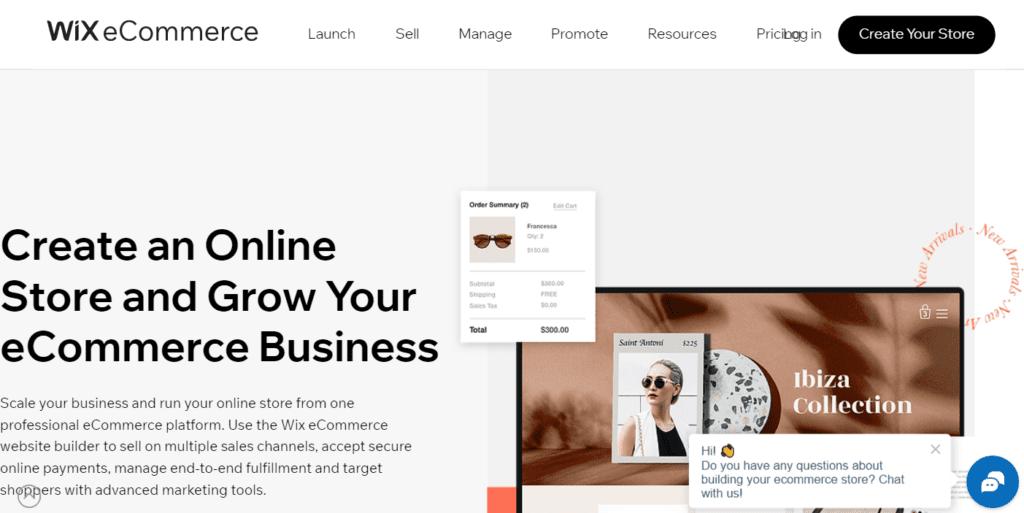
Wix ecommerce has come a long way in a few years. When I first started writing ecommerce platform reviews in 2017, Wix wasn’t even on my list. Once they got added to my list, I gave them a really poor rating and would not recommend them.
Now, Wix is a major force in the ecommerce space and they deliver amazing value for solorprenuers and small ecommerce businesses. Wix’s ecommerce features have evolved drastically in a few years, they now offer multi channel integration, abandoned cart recovery, dropship and print on demand capabilities.
In previous years, they’ve had significant issues with SEO. Few were resolved; some, like the short extra string to the URLs of blog posts and product pages still remain. That’s not ideal for SEO, especially for large ecommerce businesses.
As you grow, you might need to switch because aside from the limited features, the storage space is 20GB and if you are dealing with lots of heavy digital products or other materials, that space might not do.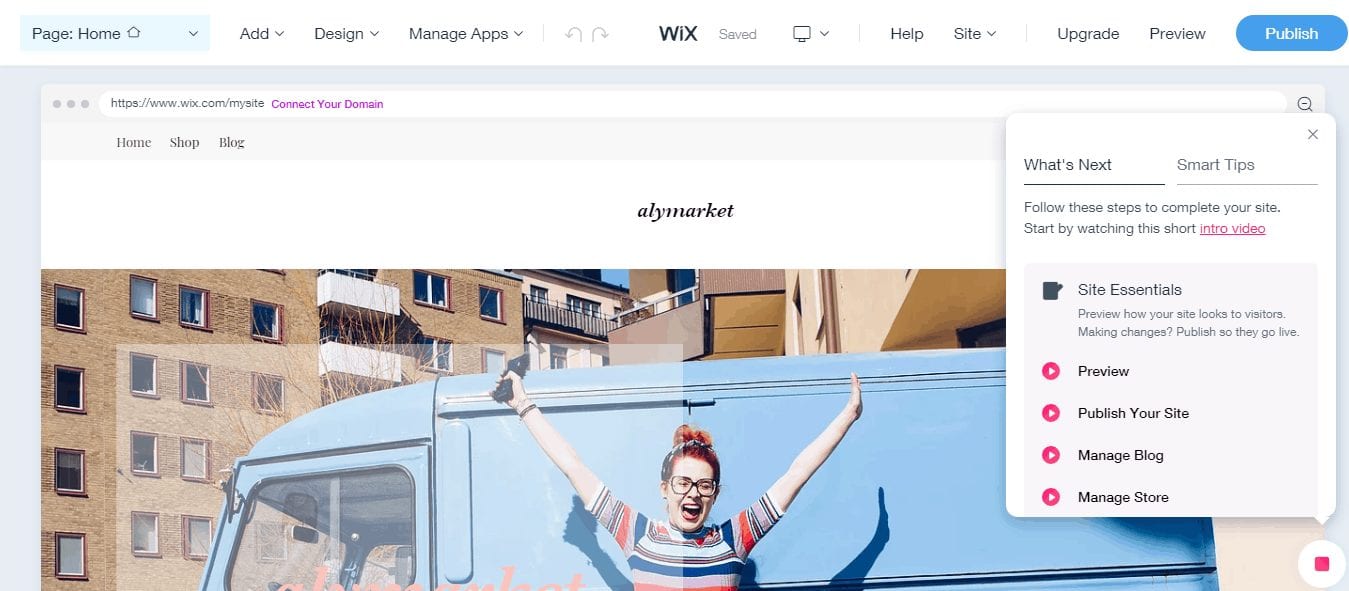
It’s beginner friendly. Of all the top website builders that I’ve dealt with, Wix topped most for on-page customer support while creating the store.
You can drag and drop elements to add cool videos, functionality, and create the website you want. They have over 500 themes of which 72 are free. Unfortunately, you’re stuck with whatever theme you chose at the time of publishing your site except if you used their ADI.
Pros
- Tons of free amazing themes.
- Really simple to use and set up
- On-page support for numerous needs
- 72 free themes
Cons
- Trying hard to fight a bad SEO reputation. Made improvements, but tested very poorly.
- Many sites were not secured
- Lacks upselling features and advanced automation
- Difficult to fully customize template
Shift4Shop
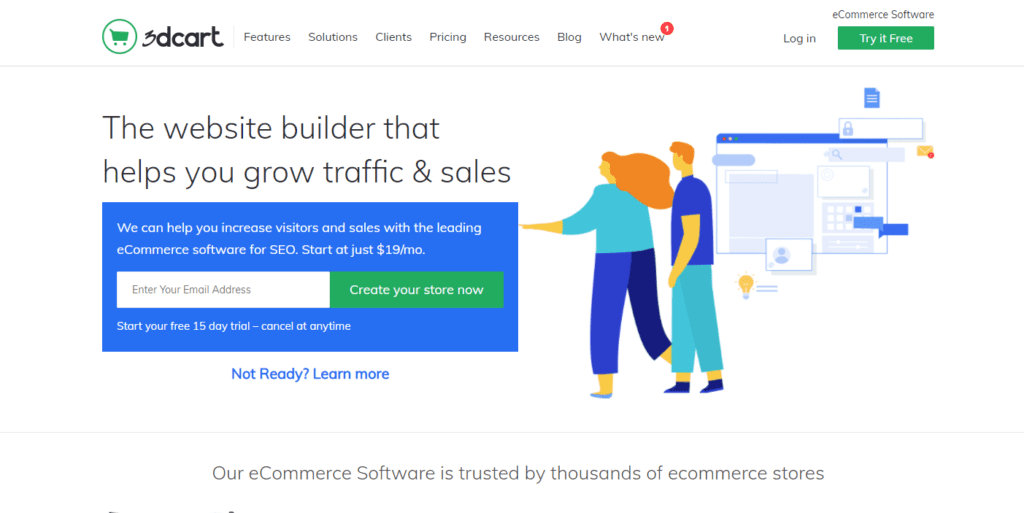
Since its release to the public in 2001, 3dcart has served over 22,000 online businesses with clientele including PCMag. They have some practical features like unlimited storage and no transaction fees. You can also use their POS, and they support multi-channel selling. In 2021, the company rebranded as Shift4Shop.
Shift4Shop doesn’t do as well as BigCommerce and Shopify despite being older than they are and the reason is clear. It’s not for beginners. Although there is a nice onboarding video when you log into your dashboard, the whole operation is hard to figure out; the builder is not very visually appealing.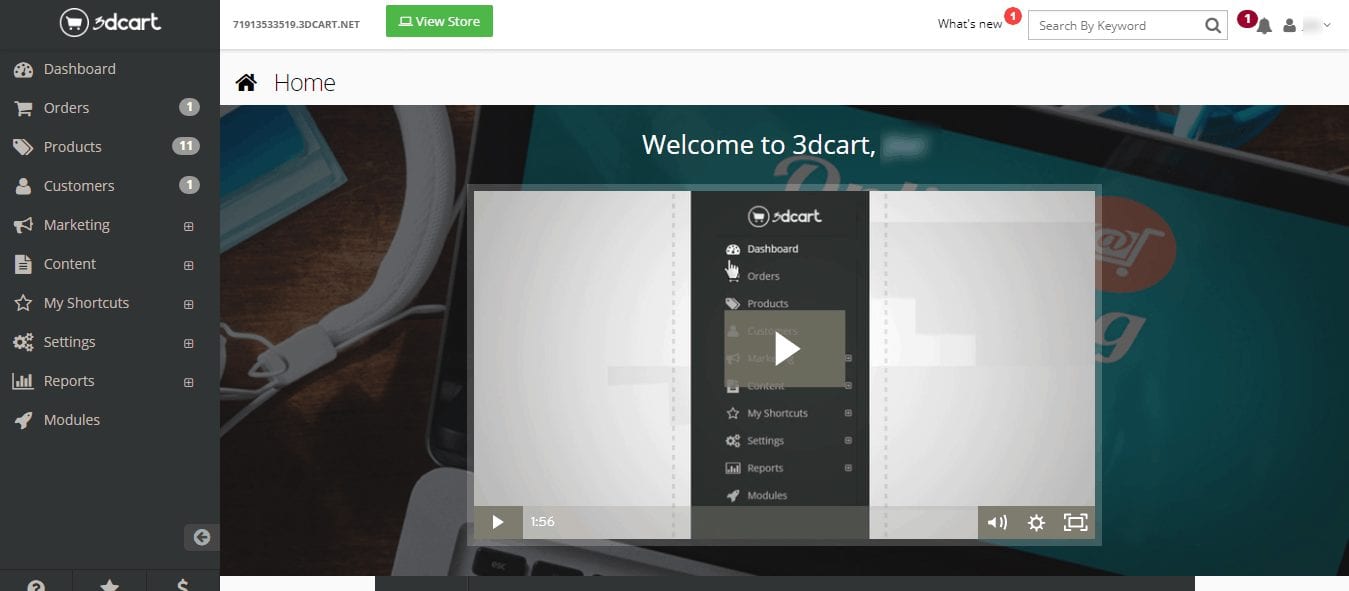
The templates they have are more industrial, but they feel outdated. Also, customizing the store takes a lot of time to understand and get used to except for experienced users because there’s no drag-and-drop functionality. Fortunately, there’s a community of developers willing to assist with theme development and other modifications.
I think one of their strongest points is in shipping; they provide advanced shipping solutions with no API required.
Similar to BigCommerce, Shift4Shoprestricts the volume of sales you bring in on each plan. The lowest which costs $19 per month allows up to 50k.
The value overall is great. I still think it’s missing out by not offering abandoned cart saver as a core feature. Shopify made a move to make it included – really undercutting the competition. Nevertheless, it still has more features out of the box than Shopify.
Pros
- Better blog feature than other SaaS ecommerce
- Supports all the integrations you would need
- Great business user management tools (email, QuickBooks, inventory, etc.)
Cons
- Templates are inline with trends, but never at the cutting edge
- Negative feedback on customer support
- Potential issues upgrading
- Not for beginners
WooCommerce
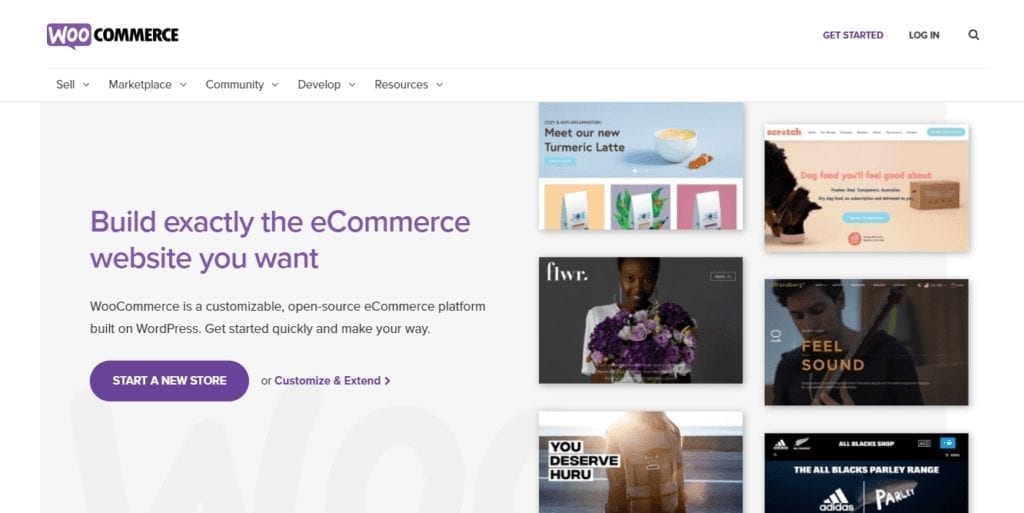
WooCommerce is the best single platform to run ecommerce and affiliate site under one roof. But the true ecommerce platforms like BigCommerce and Shopify sell better, but not by much.
It works with WordPress to turn any website into a functional ecommerce store. Also, there are extensions available for integrating payment gateways, social media, email marketing, 1-click selling, and shipping.
The biggest problem though is not the setup; that can be solved with YouTube tutorials. The problem is scalability. Most users have reported it slowing down as they get more products and customers.
For cost, it is free. Few extensions have prices attached to them, and some WordPress themes are expensive. However, you might not need those extensions, and there are good free themes.
If you are familiar with the WordPress platform, then WooCommerce is a breeze for you. You only have to install it, add your own products and fix your settings.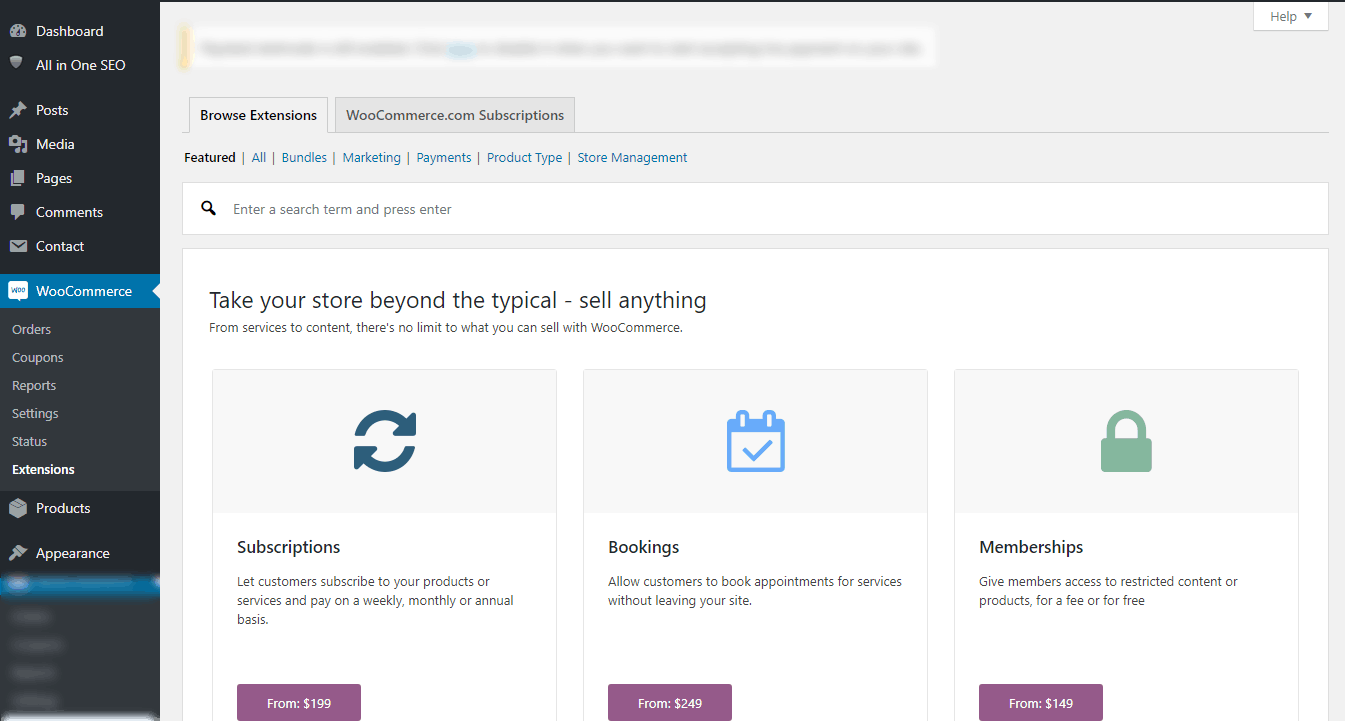
People who aren’t familiar with WordPress will struggle with the technical details. That includes buying hosting, installing WordPress, setting up your theme and plugins.
Pros
- WordPress is the best platform for SEO
- 1 Click selling app available
- Lots of WordPress experts available
- Highly customizable
- Many marketing options and plenty of other integrations
Cons
- Good hosting can be pricey
- Have to deal with blame game for troubleshooting.
- Virtually zero support
- You need extensions for simple stuff
Volusion
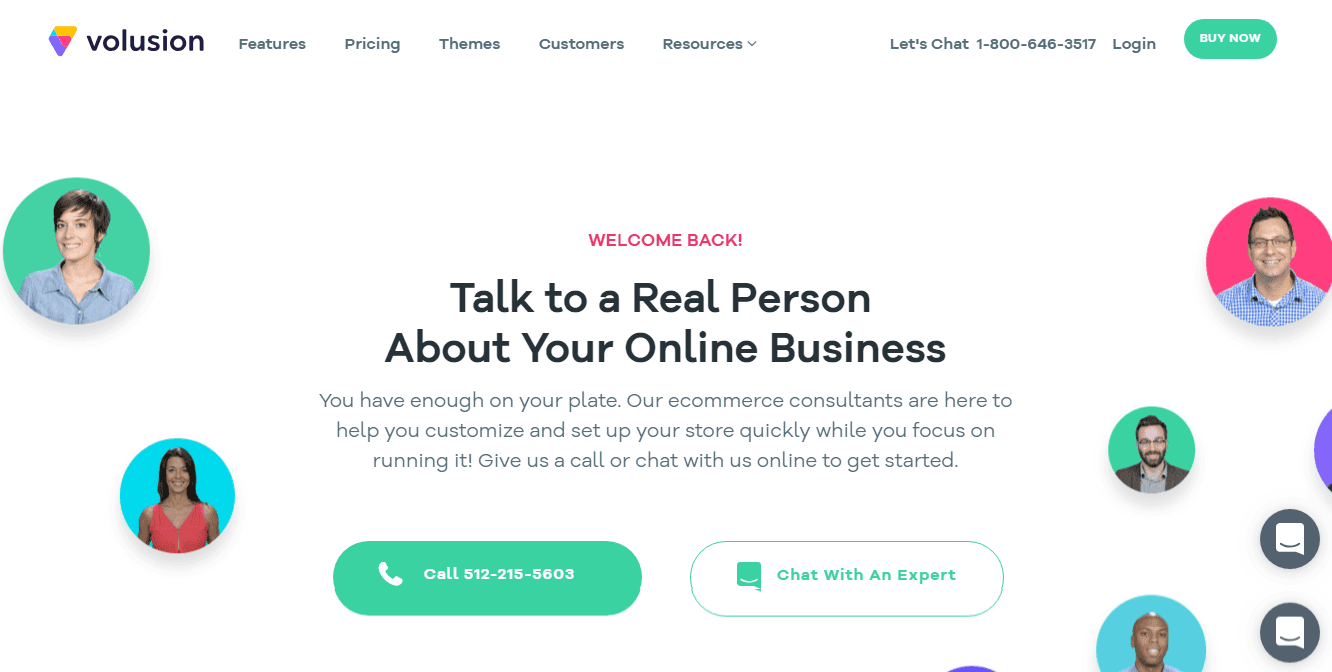
Volusion was founded in 1999 but launched in 2002 as an ecommerce solution provider. It’s a great option for those selling physical products because for now automatic digital downloads after payment is not allowed.
Volusion provides an easy to use website builder with drag and drop and in-page editing. There are 11 free themes and a good number of premium themes. Those cost about $180, and you’ll also have to purchase an SSL certificate. That is a hefty extra cost that some other platforms provide for free.
It also doesn’t come with blogging capabilities which is a huge downer mostly in this day where building SEO with blogs is king. To get that, you’ll need to use a third party like WordPress and a plugin or other means to connect the blog to your store.
The dashboard is nicely structured with all of the main action areas in the top navigation menu. You can also manage inventory and work marketing from there. The marketing options include SEO, sell on Google, eBay, Amazon, social selling, rewards, and coupons.
Their prices have a limitation to the number of products you can sell. The first two plans that cost $29 and $79 per month have restrictions of 100 and 5000 products respectively. That may change at some point because they used to have a limitation on bandwidth, but that is no more. The constant improvements give us hope.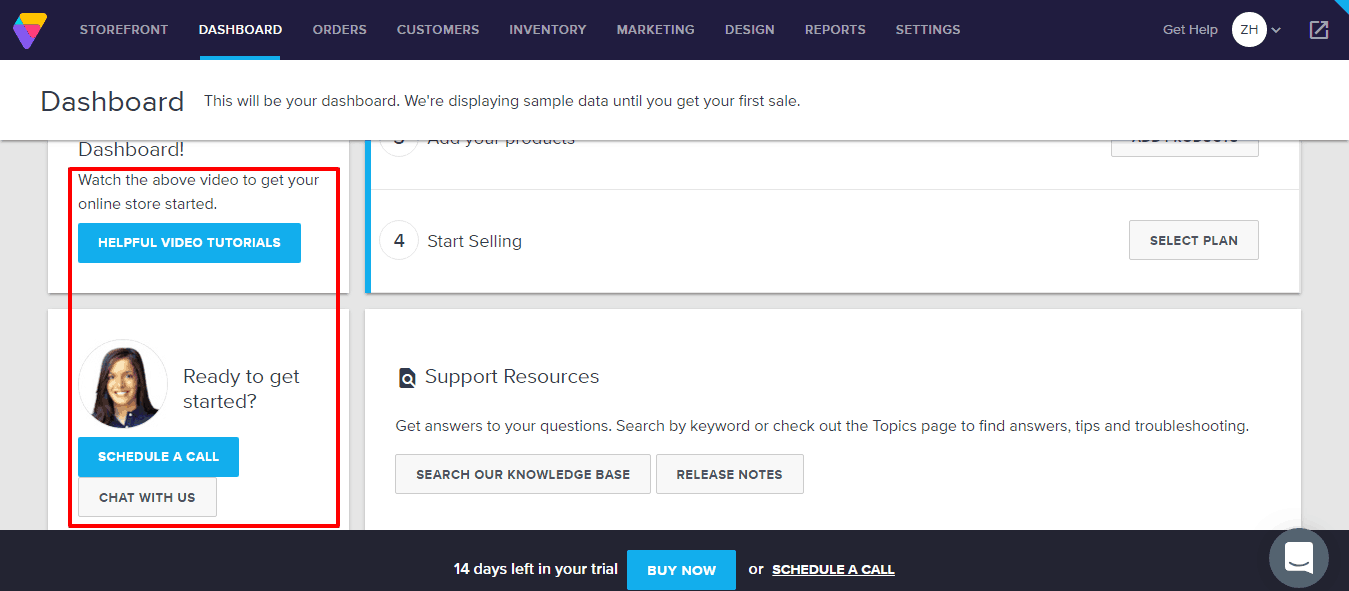
Beginner support is a big thing; from the dashboard, you’ll immediately see tons of learning materials available on how to build your store step by step with Volusion, starting and growing your online business.
All in all, it’s a solid platform for subscription ecommerce business. Dropshipping is also good but not print on demand. I would rate it higher if the Amazon integration were better, but that might not matter to you at all.
Pros
- Great onboarding and help center
- Great flexibility with Sitemaps
- Built-in subscription/recurring payments
- SMB friendly
- Well laid out dashboard
- Clear inventory and marketing system
Cons
- Lacks up/cross selling features
- Many sites had poor URL structure
- One of the slower SaaS platforms
- Many of the sites I studied looked VERY dated
- No built-in blogging functionality
Prestashop
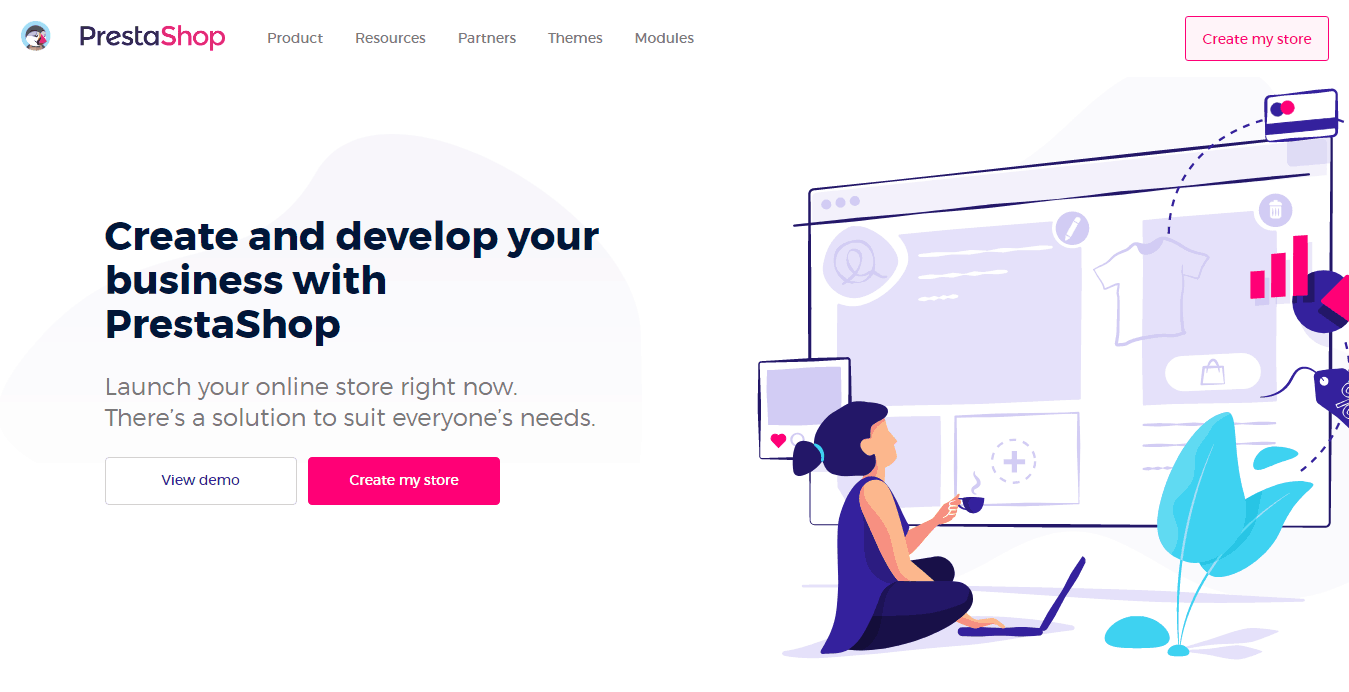
Founded in 2007, PrestaShop is an open-source and cloud-hosted ecommerce platform that gives the best overall value.
While the word “free” automatically makes most of us salivate, the other costs you will accrue with the free version might make the PrestaShop Ready look like a better option especially if you don’t have the technical skills.
With the free downloadable version, you’ll have to pay for web hosting, SSL certificate, and other modules to complete your store. Also, if you don’t have the heavy technical skills in HTML, CSS, and/or PHP, you’ll have to pay a developer. Nevertheless, that open-code allows extensive integration with couriers, payment gateways, accounting, warehouses, ERP, and more.
You have access to the 16 days trial or pay straight away. It comes with the SSL certificate.
There are ten themes (all free) available in the admin. You might need little knowledge of HTML and CSS as the theme customizer doesn’t have a drag and drop functionality.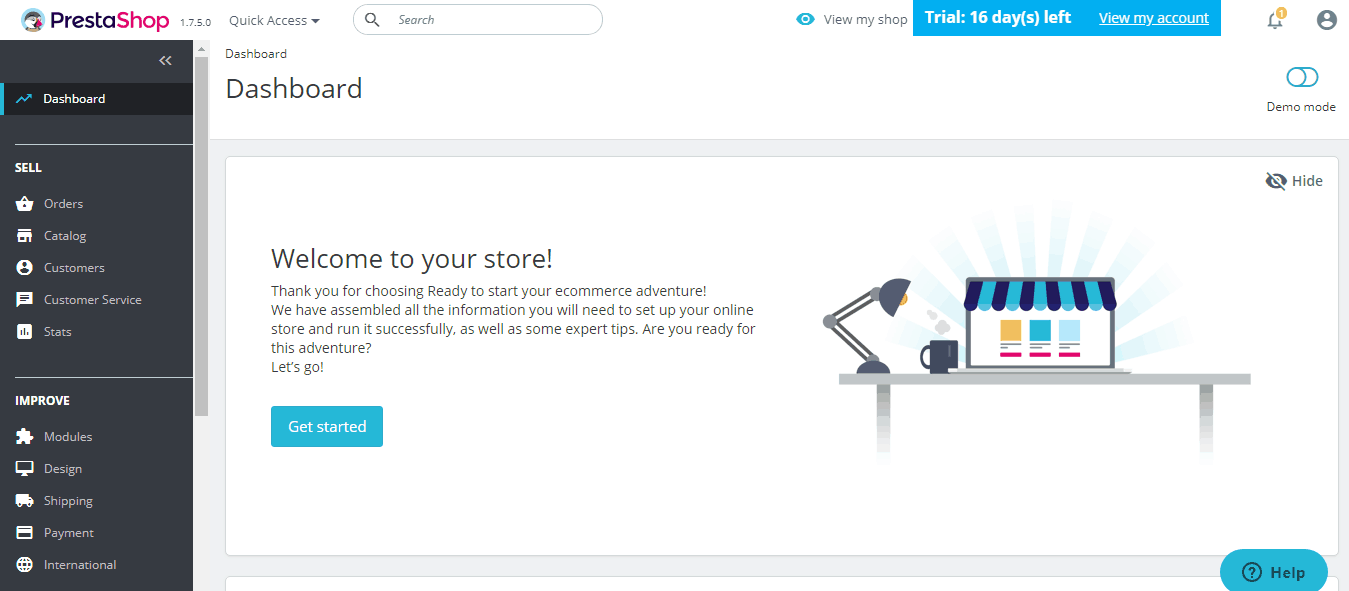
The dashboard is straightforward and simple. There’s an onboarding video, but it’s not as comprehensive as Shopify. However, you can achieve most needs through modules that you enable with one click. Those allow better SEO working, Ads, Cross-selling, and social analytics.
Pros
- Tons of apps/integrations available
- Strong SEO
- Open source very flexible
- Large and ready-to-help community
Cons
- Slower than the other builders
- Add-ons can add up
- Limited third-party marketing integrations
- Developer skill needed to tweak
- No multichannel functionalities on the hosted version
Weebly
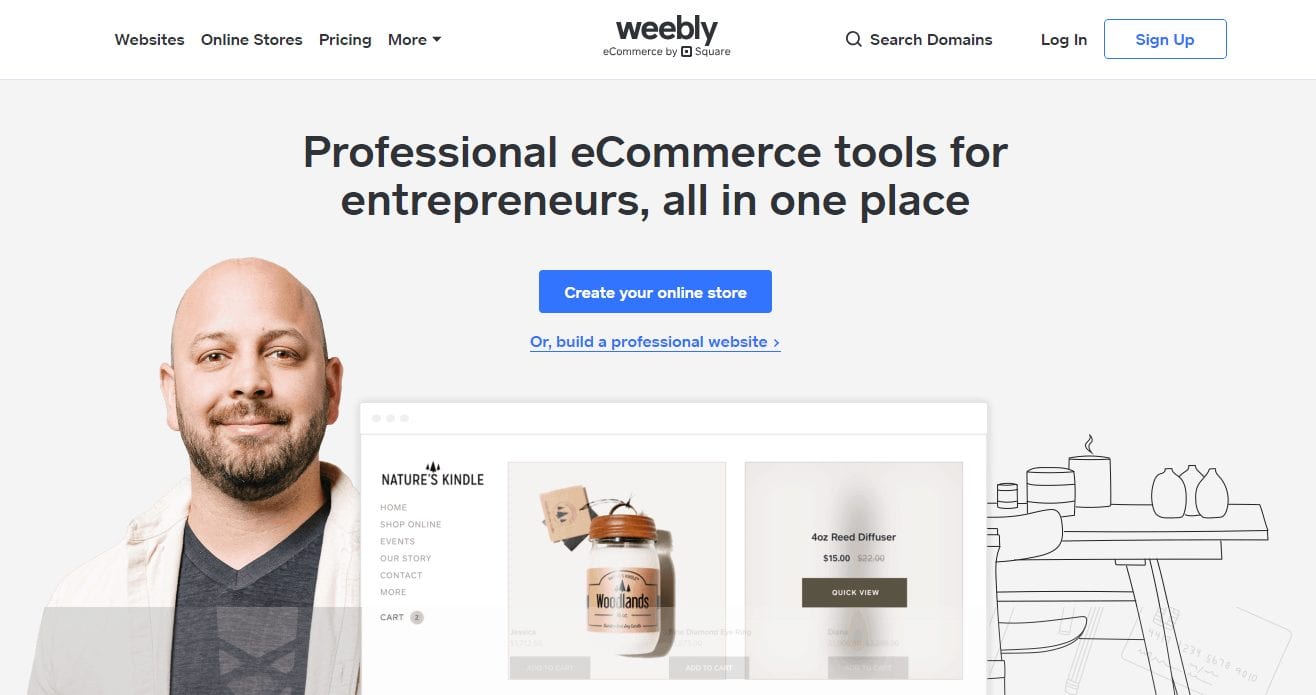
Founded in 2006 and with about 40 million customers, Weebly is a great option for someone looking for a simple store with marketing automation built in. That will cost you $38 per month vs. using Shopify and Active Campaign ($29 + $17). But if you plan to do any type of marketing, you’ll quickly outgrow Weebly. Don’t use Weebly if SEO is important to you.
Until recently, there hasn’t been a solid focus on ecommerce, and as such, you wouldn’t find some of the sophistication that other top platforms have. Nevertheless, it remains an excellent choice for startup entrepreneurs or those who do not wish to hire a developer.
Weebly has three price plans, and though they all support ecommerce, the higher two (Business and Performance) are better suited for ecommerce businesses. The reason is that the starter plan is lacking in many relevant ecommerce features like custom shopping cart, coupons, and inventory management. Also, you can’t sell digital goods on it. For physical goods, you’re restricted to 25 products with a 3% transaction fee.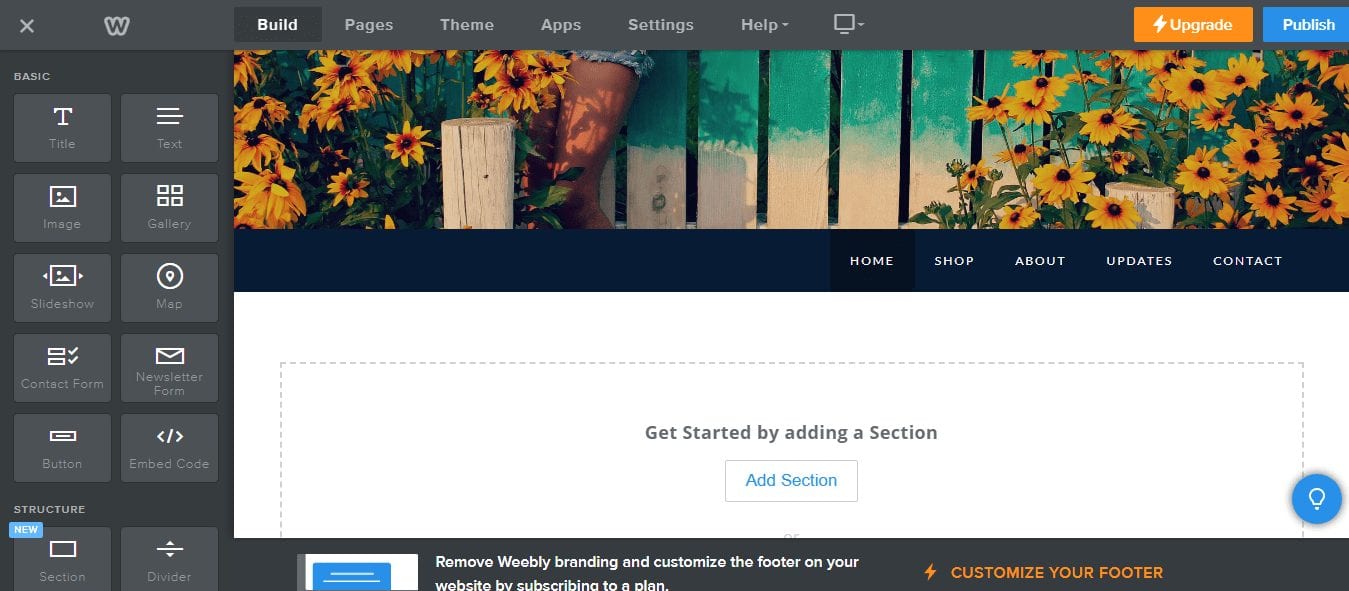
There’s a drag and drop editing tool and an option to use HTML and CSS to customize your template. About that, there are many free themes with premium themes at around $45. Not all are mobile responsive though so choose carefully.
Weebly is an easy to use platform. They offer the basic tools you need for a functional store without flashy extras to confuse you. You can upload products in bulk, and the dashboard is simple.
Another feature worthy of note is the mobile app that you can use to manage your business and print shipping labels.
Pros
- Excellent value
- Lowest price for ecommerce marketing automation
- Stunning low cost and free designs
- Powerful email tools
- Simple dashboard that’s easy to use
- Mobile app
Cons
- Charges an additional transaction fee
- Sucks with SEO
- Amazon doesn’t seem to be on their radar
- Inventory management is still very basic
Squarespace

Squarespace is another one of those platforms that offers drag-and-drop. Founded in 2003, they have sleek templates and design capabilities.
If you don’t need a lot of features, try them out. It’s also great for print on demand ecommerce business.
The prices are quite low. To start selling, you need to at least be on the Business website plan that’s $18/month when billed annually. Note that you’ll have to pay 3% on transaction fees.
You can escape that with any one of the ecommerce plans at $26 and $40. The top plan allows you to get abandoned cart auto recovery, sell subscriptions and gift cards, and give flexible discounts.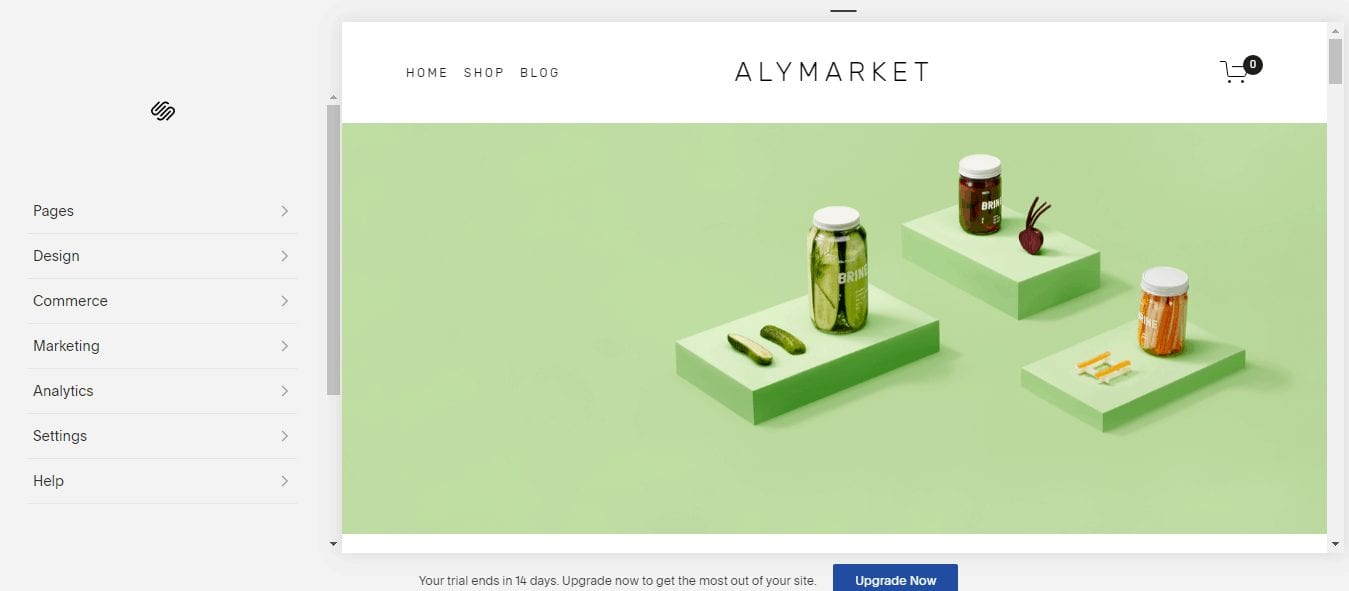
The package comes with all the basic features you’d expect from an ecommerce platform all arranged on the side menu.
The website design part is not that easy though. Their drag and drop editor is not as great as Weebly’s. You might have to try your hands on it a few times before you get the hang of it. When you have gotten past the website design phase, you’ll enjoy the access to marketing, inventory, social selling, SEO, and analytics features.
Squarespace integrates ShipStation and allows you to install Printul and ShipBob from the app section. Real-time calculation of shipping rates from major providers (UPS, FedEx, USPS) is also available.
The biggest downsides are payment processors and third-party applications. They only support Stripe and Paypal. As for the apps, they only integrate with very few third-party tools.
Pros
- Easy To Set Up
- Great For Simple Stores
- Stunning Designs
- Solid SEO tools
- Integrates with ShipStation and ShipBob
Cons
- No dropshipping
- No marketing automation integration
- No Amazon integration
- Could be faster for the price
- No app store for more features and functionalities
Magento
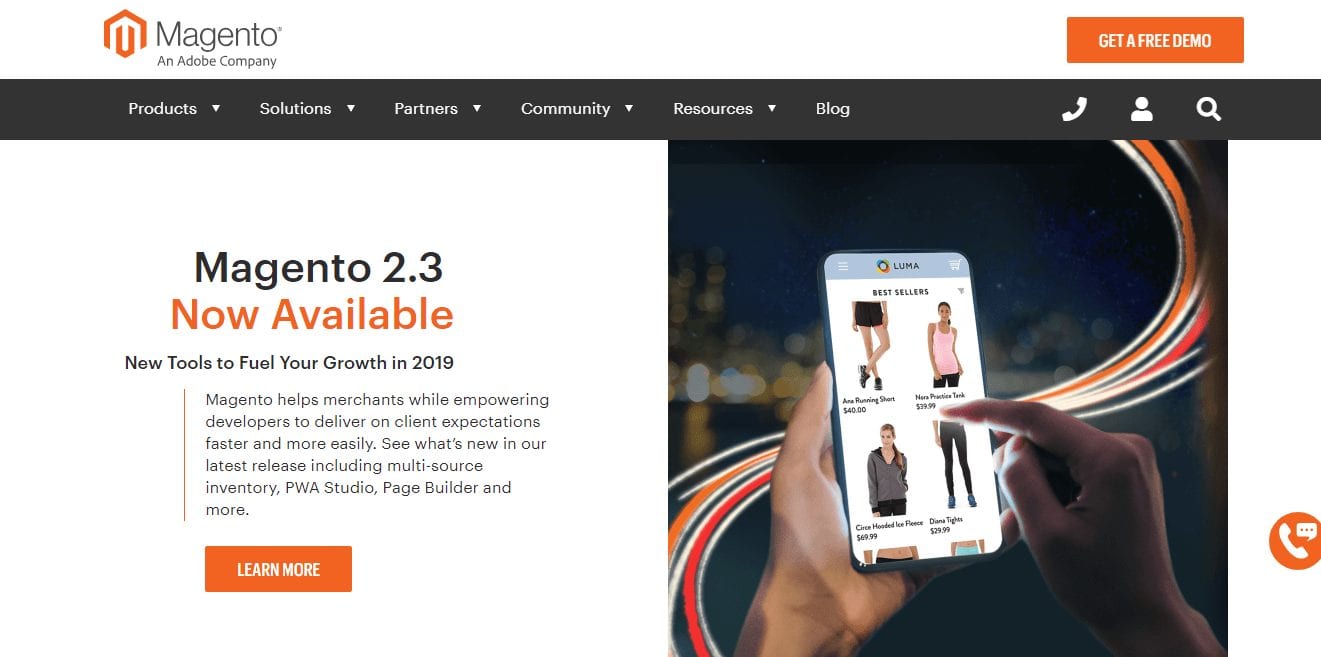
The large brands like Nike, Procter & Gamble, and Cisco trust Magento. Coding is an integral part of the package. So, if you have a developer or the budget for one – and want something truly customizable and powerful – Magento is a solid choice. You can do and undo till you get the feature-rich online store you want.
A big part of Magento is the community. It’s large with developers willing to work on your store for a fee or answer some of your questions free. There’s also a marketplace where you can get extensions and themes to increase the functionality of your platform.
Magento’s most used free, but there’s a paid level for enterprise solutions for large ecommerce businesses. It is expensive; the annual licensing fee runs in tens of thousands of dollars. That’s huge, but it’s on the cloud, faster, and comes with additional features including automatic trigger-based email campaigns and automatic cross /upsell.
Whichever you pick, you’ll enjoy the long list of features that you can extend. Things like discounts, recurring payments, ability to grind SEO, adjust content per user, membership subscriptions, unlimited products, and more.
Pros
- Robust and feature rich
- Strong SEO
- 1-Click selling
- Lots of users and community
- Scalable and highly customizable
- Flexible to choose where you want to host the software
Cons
- Pricey themes.
- Easily Slowed Down
- Requires Development Skills
- Virtually no support.
- Requires ample space and memory to perform well
Best Ecommerce Platform For Small Business
Small businesses don’t need all the big features that suck out money from their bank. Asides the cost, the pricing structure of the platform is important – be it month to month or yearly payments and other fees.
In our testing, we also checked scalability. That looks at the features that help your website grow. Once your sales start to pick up, you’re going to want to scale your operations seamlessly. That means going multi-channel, selling on other platforms and even countries. You might also need apps made just for your business as you scale.
Recommended Platforms
- BigCommerce
- WooCommerce
- Wix
Best Ecommerce Platform For Startups & Beginners
The e-commerce market is booming, and internet-savvy individuals want to have an online store to connect with customers. Starting an ecommerce business also means coming face to face with every new trend that seems a basic necessity and high expectations from e-commerce platforms.
Like small businesses, startups also need a platform that allows them to scale effortlessly and break through the already existing guys. Since you might be entering the market as a big store owner, your platform needs to be able to handle what you bring in initially while giving room for more growth.
Our testing checked the functionalities that startups need. That includes SEO, good UX design, marketing inputs, and the ability to sell on multiple platforms like mobile apps and social networks.
Look at each platform’s performance based on these metrics.
Ease of Use
First-time ecommerce entrepreneurs should be able to launch and run a store on their own without having to call a developer for every last thing. So we gave extra weight for the ability to set up and run your store code free.
| Platform | Ease of Use | Phone Support | 24/7 Support | Chat Support | Community Rating | # of Apps/ Plugins |
|---|---|---|---|---|---|---|
| Shopify | 4.9 | Yes | Yes | Yes | 5 | 5,000 |
| BigCommerce | 4.8 | Yes | Yes | Yes | 4.0 | 1000 |
| Woocommerce | 3.3 | No | No | Yes | 4.0 | 250+ |
| 3dcart | 4.3 | Yes | Yes | Yes | 3.0 | ~250 |
| Volusion | 4.1 | Yes | Yes | Yes | 2 | ~20 |
| Magento | 2.2 | No | No | No | 4 | 3000+ |
| Prestashop | 2.9 | Yes | No | No | 3 | 3000+ |
| SquareSpace | 3.8 | No | Yes | Yes | 3.0 | 10+ |
| Wix | 4.2 | Yes | Yes | No | 4.5 | 700 |
| Weebly | 3.6 | Yes | No | Yes | 2 | ~350 |
From our analysis, BigCommerce and Shopify are at par in ease of use scores. You don’t need to be the master of web dev before you can use them and there’s a ton of support. 3dcart and Wix come close.
But Wix is not the best option for ecommerce and WooCommerce kills all-in-one for beginners/startups especially for optimizing costs and growing SEO.
Recommended Platforms
- BigCommerce
- WooCommerce
- Shopify
Best Ecommerce Platform For SEO
SEO is crucial. You’re going to have a hard time running an ecommerce store if users of the net can’t discover your website through a search engine. Many platforms offer some SEO tools to boost your website. Nevertheless, some are better than others.
In our testing, we based the best ecommerce platforms for SEO on page load time, mobile and desktop speed, SEO, and average organic traffic of top online stores using each platform.
| Platform | Performance | Load Time | Mobile Speed | Desktop Speed | Avg SEO Traffic |
|---|---|---|---|---|---|
| Shopify | 3.9 | 1.3 | 63 | 75 | 11717 |
| BigCommerce | 4.5 | 2.2 | 63 | 80 | 33626 |
| Woocommerce | 3.1 | 3.4 | 42 | 52 | 72968 |
| 3dcart | 3.0 | 2.8 | 50 | 58 | 9703 |
| Volusion | 2.9 | 3.5 | 48 | 56 | 15779 |
| Magento | 2.8 | 4.8 | 39 | 43 | 19408 |
| Prestashop | 2.9 | 4.62 | 50 | 52 | 33851 |
| SquareSpace | 3.5 | 3.5 | 42 | 63 | 5678 |
| Wix | 3.9 | 3.2 | 69 | 81 | 543 |
| Weebly | 2.6 | 3 | 49 | 59 | 186 |
Platform SEO Performance
“SEO is dead.” – People who don’t know how to do SEO.
Can we just tell you how sick of hearing that, and how wrong it is, once and for all?
Excuse me while I rant, but you need to know your SEO. Keyword stuffing and content written for robots and spiders was never a smart move, and sure, it’s penalized and anyone who practices it should be punished.
Bad SEO is dead. It should be.
Good SEO, on the other hand, is alive and well. The best SEO practices will catapult you to the top of Google’s coveted search results, and win friends on Yahoo! and Bing, too. You’ll generate more organic traffic, saving you cash on leads. SEO is a crucial part of site design and performance, and there are plenty of ranking criteria to consider for your ecommerce enterprise.
Making it easy for humans and robots to navigate is a good first step – and that takes using the right URL structures. Site promotion and honest, white hat backlinking are also smart. That’s good SEO.
SEO Friendly URLs
URLs are super important. Do NOT skip over good URL structure.
It’s not something you can make up for through great content and backlinks. Although we hate to point fingers and bring up bad examples, we’re begging you.
Don’t ever let your URLs look like this:
http://purplesagetea.com/epages/472f26ef-dbcc-482e-8f37-4e8a0b5ede3c.sf/en_US/?ObjectPath=/Shops/472f26ef-dbcc-482e-8f37-4e8a0b5ede3c/Categories/Category3 (via 1&1/ePages)
Great selection of teas, but between the slow load time and the painful URL, we’re betting their shop isn’t making anywhere near what it could be.
They’re lacking good technical SEO.
Search engines like to keep things simple and easy for the end user. Bulky, huge URLs are NEVER user-friendly. They’re not good for your business, either. Short, relevant URLs are an important ranking factor. Good for usability.
WooCommerce is by far the best for SEO. Magento doesn’t do bad either. That’s because you can customize everything and expand your functionalities.
From our stats, I’d say – stay away from Shopify if SEO is your top priority. They still need lots of improvement. Where’s WooCommerce scored 5, they got 2.5 and the median is 3.7. It’s not surprising that where the average organic traffic score is 20,346, Shopify only passes half of that by a thread but Woo is at a 70+.
Load Time
Load time is a pretty straightforward indicator of how fast your site is. Simply put, it’s the measure of how long it takes a page (or pages) on your site to fully load. A slow site is a killer in ecommerce – potential customers run away from slow sites, and as we mentioned earlier, each second you gain in site loading speed translates directly into sales gained.
In ecommerce, speed is money. Every second your site takes to load is costing you. A lot.
According to research by Akamai, most consumers want sites to load in 3 seconds or less. The median load time for the top 500 ecommerce sites is 10 seconds.
According to our data, the load time for average ecommerce sites is 3.2 seconds, but the platform you use makes a big difference. For example WooCommerce sites tend to load in 3.4 seconds, while 3dcart sites tend to load in under 3 seconds.
There’s more – a 1-second improvement in load time equates to a 7% increase in conversions. Wouldn’t that be nice?
If you’re running a self-hosted platform, you can optimize it for speed, but again that takes time and effort. Most self-hosted sites don’t bother; the average Magento site loads in 5 seconds. Forget collecting any credit card payments with that slow site.
Price might be the problem – optimizing for speed isn’t cheap, and ironically, can take a lot of time.
An out-of-the-box solution that offers great loading speed is a secret weapon in your ecommerce arsenal. Don’t underestimate the value of this metric.
Speed performance is so important; we collected multiple types of data (from 2000 ecommerce website domains) to determine how well a site performs.
Google PageSpeed
Google’s PageSpeed Score is based on several factors that rate your site’s speed and usability. Across the board, you’ll notice poor mobile speed scores. The average score is 51.5/100.
Marketers and developers are really starting to feel the mobile speed crunch. Mobile users expect pages on their mobile devices to load faster than desktop. Companies like Google are focusing on projects like AMP to make mobile pages load faster.
Google PageSpeed tests desktop speed as well. Check out the data below on the performance of various platforms.
Recommended Platforms
- WooCommerce
- BigCommerce
- Magento
Best Ecommerce Platform For Dropshipping
In dropshipping, you’re not in control of many things; product quality and returns might be a hurdle. Also, there are technical stones that you need to move to keep your orders leaving as fast as they enter your ecommerce system if you’re going to dominate the supply of that product.
When evaluating, we looked at these features:
- Ability to sync with supplier’s inventory
- Support of many dropshipping plugins
- Automating different suppliers or SKUs for the same product
- Tracking of order both from your and end customer’s side
- Free/paid dropshipping integration
Recommended Platforms
- Shopify
- BigCommerce
Best Ecommerce Platform For Local Brick and Mortar
Most local brick and mortars only need a basic simple store. For example, if you’re a local bakery looking to accept payments on your website – you don’t need a feature rich platform. In this case, we ignored marketing automation or multichannel because let’s be honest, you don’t need it.
Don’t let greedy developers deceive you into paying for such because it happens – a lot. So, we looked at the ability to create a website and add a payment gateway easily. No advertising or shopping cart recovery here.
Recommended Platforms
- Shopify
- Wix
- Weebly
Best Ecommerce Platform For Large Businesses
If you run a large ecommerce business, you might want complete control and server autonomy. In that case, you’re looking at buying a dedicated server or VPS from a web hosting company and set up your platform in there. As such, SAAS like Shopify will not satisfy you.
However, if you’d rather set it up and not bother yourself with web hosting technicalities, then a platform like BigCommerce could be it.
Since you have orders ranging in hundreds or thousands weekly, you’ll need a platform that gives you enough flexibility to connect software, helps you reduce errors, and seamlessly integrates your warehouse management and other inventory systems. We also considered platforms that enable multiple currency and store, allows integration with Google services, and 3PLs.
Recommended Platforms
- BigCommerce
- X-Cart
- Magento
Design Considerations For Ecommerce Platforms
Your website should deliver a rich and smooth experience that entice customers to visit your site, make them stay, and convince them to buy. One crucial place that starts is the design. Too often, online stores go all out with complicated designs that do nothing more than slow down the load time and annoys visitors. Every design you choose should be with the aim to hook potential customers.
The same goes for the navigation, and checkout process.
| Platform | Design & Themes | Visual Design | Mobile UX | Cost Of Premium Themes | # of Free Themes |
|---|---|---|---|---|---|
| Shopify | 4.0 | 5.0 | 97 | $140 | 9 |
| BigCommerce | 3.8 | 5.0 | 94 | $150 | 12 |
| Woocommerce | 4.3 | 3.0 | 97 | $39 | 1000+ |
| 3dcart | 4.3 | 4.0 | 95 | $200+ | 50+ |
| Volusion | 3.7 | 4 | 92 | $180 | 18 |
| Magento | 3.7 | 5.0 | 5 | $300+ | 1 |
| Prestashop | 3.2 | 4 | 94 | $29+ | 0 |
| SquareSpace | 4.3 | 5.0 | 5 | 100.00% | 14 |
| Wix | 4.7 | 5.0 | 92 | 0 | 72 |
| Weebly | 4.3 | 5 | 97 | $45 | 15 |
These are things you should look out for:
Customization
To get the best, you’ll need to tweak some features in your ecommerce platform. About that, Shopify checkout process is limiting. The changes you can make to the checkout pages are minimal except if you pay for Shopify Plus. Sure, Shopify Plus has its benefits, but if you don’t need most of them, paying at least $2000 every month only for the sake of the checkout page might be total madness.
If you’re thinking WooCommerce, you can customize almost everything due to child themes. This is one place that self-hosted platforms do well.
A bonus tip I’ll leave here is Elementor. The drag and drop builder plugin is very powerful when combined with the BigCommerce or WooCommerce plugin. You can create advanced price tables, price list and products widgets, customize your checkout page, order tracking, and optimize the mobile view of the website without coding. Another plus is that it’s translation ready; your store can read in Spanish to someone in Mexico and French to another in France, taking marketing to another level.
Theme Selection
Your theme is the frontline for any tweaking you will do. If you’re a beginner to coding or your platform doesn’t allow much for developer re-coding, you need to choose a theme that meets your needs and suits your customers. In picking the right theme, look out for the one that’s best for your niche and what other ecommerce sites are picking.
Another thing is cost. While you can get a large number of free WordPress themes, Shopify and BigCommerce are restricted to 9 and 7 respectively. You’ll have to pay for the other great guys that you might prefer. If you’re into spending more for the best, you can reach out to an expert to customize a theme for you or design one from scratch.
Ecommerce Mobile Performance
What is it about mobile? More than a passing fad, mobile tech is an ecommerce retailers’ dream. Mobile-friendly sites are a must have for all e-retailers, and with good reason –
- 66% of the time spent on online ecommerce is done through mobile devices
- 82% of smartphone users turn to their devices to help them make a product decision
Customers want mobile-friendly ecommerce website design, and the market is showing that mobile commerce is growing 300% faster than ecommerce, which means your site also has to have a responsive design.
To get the most out of mobile site design, you need to make sure your online platform is easily upgradable. Look at live sites to see what works and what doesn’t.
Test your site repeatedly and on multiple devices, and don’t forget to keep your mobile set heavy on the visuals and with a font that’s large enough for everyone to use – not to mention easy and intuitive navigation.
Take a true mobile-first approach with your design and UX loading performance.
In this regard, WooCommerce, Shopify, and Weebly wear the crown. All being at or above the median score of 94%.
Mobile User Experience
About 40% of total purchases during the 2018 holiday season were made on a smartphone. And about half of the traffic to ecommerce stores come from mobile devices. That’s against the one fourth that was recorded in 2017. Mobile ecommerce is growing so fast that you need to not only think about responsive design but also the best possible experience. One way to go about this is the Google Mobile User Experience Score.
Google’s Mobile User Experience score offers an excellent idea of just how much your website will frustrate mobile users…or not. This score tries to mimic how a real user interacts with the page.
According to a post on Moz, five key factors to consider for mobile user experience include:
- Viewport configuration
- Font legibility
- Use of incompatible plugins
- Content to viewport
- Size and proximity of links
All platforms but Wix did well here. This is more of your work though.
Read Sharon’s article to learn more about fixing common mobile UX mistakes.
Must Read:
2021 Recommended Platforms
There’s no perfect ecommerce platform, but I’ve narrowed down the top choices.
Choosing the best ecommerce site builder is really based on your needs. We do want to recommend that you consider a few as front-runners – BigCommerce was by far the best overall platform for any business model and performs excellently for SEO.
WooCommerce is catching up with market leaders like Shopify in terms of features and apps. Perfect for private/white label ecommerce sites. Awesome for affiliate marketing. And the strongest option if you want to run a private label & affiliate marketing combo site.
Shopify is the best platform for dropshipping, including print on demand.
Wix works for simple stores. If I were running a local bakery that takes few online orders, I’d choose Wix over Squarespace or Weebly. Wix has come a long way in a few years and its perfectly priced for soloprenuers or small stores.
If you’re considering Magento, X-Cart is worth a look. It’s one of the best free ecommerce platforms if you have dev resources. Plus it has made a lot of investment in expanding the product and brand in recent years.
Most ecommerce platforms do a decent job. There is a handful we’d warn you to think twice before committing to, including Magento, Open Cart, Jigoshop, ePages (1&1), WP Ecommerce, CoreCommerce, and Big Cartel. There are much better options available at similar price points. Still, many people use and love these platforms.
Not sure what the best ecommerce platform is for you? Drop me a comment below!

